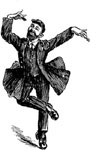
The Dubious Pedigree of Touchie-Feelie Catholicism
GUEST COLUMN
This past Ascension Thursday, my husband noted that during the Mass we went directly from the “Our Father” to the Agnus Dei. “None of that handshaking stuff tonight,” he commented approvingly. When I pointed out to him that the “sign of peace” was omitted on weekdays, he replied, “I’ll bet Father wishes every day were a weekday.”
So do I, if it would mean no more handshaking during Mass. The sign of peace ritual disrupts the rhythm of the Mass, as it moves from the major climax of the Consecration to the minor parallel climax of the Agnus Dei. It is disruptive as it turns the people’s attention away from the Eucharistic activity on the altar and toward each other. Up to and through the Our Father, the people face forward, but during the sign of peace, they face one another. At the Agnus Dei, they are supposed to turn their attention back to the altar and the Eucharist.
This doesn’t always work, as I’ve had people try to grab my hand even while I’m reciting the Agnus Dei, with my eyes fixed on the altar. No matter that some of us are trying to pray (in a church, no less), my shake-happy pewmate’s religious experience cannot be complete unless he has clasped the hand of everyone within reach.
That’s why I’ve thought sometimes that the priest should have a bullhorn instead of a clip-on microphone. With a bullhorn, he could blast out the Agnus Dei, leaving no doubt in the pews that the handshake period is over, folks, and it’s time to get back to the Eucharist.
You May Also Enjoy
If a Catholic church building doesn't reflect Catholic theology, the worshiper risks accepting a faith that is foreign to Catholicism.
A Carmelite monastery in Wyoming is an exciting new element in the Church in America, and has proven to be fecund ground for vocations to the consecrated life.
Shall we correct "At thy great name exalted now, all knees must bend, all hearts must bow" to "At thy great name exalted now, all folks jump up, all in a row"?

